 Visitors to the park know it can be busy during the daytime; just visit Cochran Shoals on the weekend and you'll understand. People may be the most commonly spotted creature during the daytime, but for our animal inhabitants, the nighttime is the right time! (NOTE: The park closes at dark- please make sure to obey all park rules.) While it's fun to try to stay up and see some of the nocturnal goings-on, here in SRM we use cameras to capture photos of the wildlife when we're not around. These special cameras use infrared, so there's no flash to scare the animals off- and we get to see some pretty cool things.
Visitors to the park know it can be busy during the daytime; just visit Cochran Shoals on the weekend and you'll understand. People may be the most commonly spotted creature during the daytime, but for our animal inhabitants, the nighttime is the right time! (NOTE: The park closes at dark- please make sure to obey all park rules.) While it's fun to try to stay up and see some of the nocturnal goings-on, here in SRM we use cameras to capture photos of the wildlife when we're not around. These special cameras use infrared, so there's no flash to scare the animals off- and we get to see some pretty cool things.
In each installment of the Park After Dark, we'll get to know a little more about one of the species of animals living in the park. Since this is our first one, we'll start with the largest mammal in the park, and also one that's fairly frequently seen.

- Height: 1 3/4 - 3 1/2 feet at the shoulder
- Weight: 50-300 pounds
- Lifespan: Up to 20 years, but generally about 10 years in the wild.
- Coat: Grayish in winter, reddish-brown in summer. White belly. Relatively long tail, which is white on the underside. When alarmed, the White-Tailed Deer raises and wags its tail- like a white flag.
- Mostly nocturnal, the best times to see them are near dusk and dawn.
- Natural predators include bobcats and coyotes. (Look for future installments of the Park After Dark to learn about these!)
The White-Tailed Deer can be found in most parts of the United States, and is the only cervid (an animal that grows antlers, not horns) found in Georgia. What's the difference between antlers and horns? Antlers are bony growths on male deer (bucks) that begin growing each spring, and are covered by skin and fine hair called velvet. Once the antlers have finished growing, the buck rubs his antlers on trees to scrape the skin and velvet off, leaving just the bones. You may notice trees missing bark- sometimes the bucks rub the bark off with their velvet! The bucks keep their antlers through mating season- called the rut- and then they drop off one at a time, usually by the end of December.
Antlers aren't just there to look cool; they help bucks fight off competition during mating season. Younger males have antlers with just a single point or tine, while older bucks develop branching antlers with multiple tines- which gives them an advantage when butting heads with other males.
 |
About seven months after the rut, a female deer (called a doe) gives birth to one, two, or three offspring (called fawns). The fawns are reddish-brown with white spots (think Bambi) which fade after three to four months. A doe generally gives birth to a single fawn when she is two years old, and then twins every year after.
The White-Tailed Deer is an opportunistic herbivore, grazing on most available plant foods, including twigs, berries, fruits and nuts, grass, corn, alfalfa, and even lichens and fungi! They thrive in suburban settings and do not discriminate against plants available in yards and landscaping. One way to discourage them from eating your plants is scattering human hair (from a brush or haircut trimmings) around the plot. Just make sure to replace it after a heavy rain!
